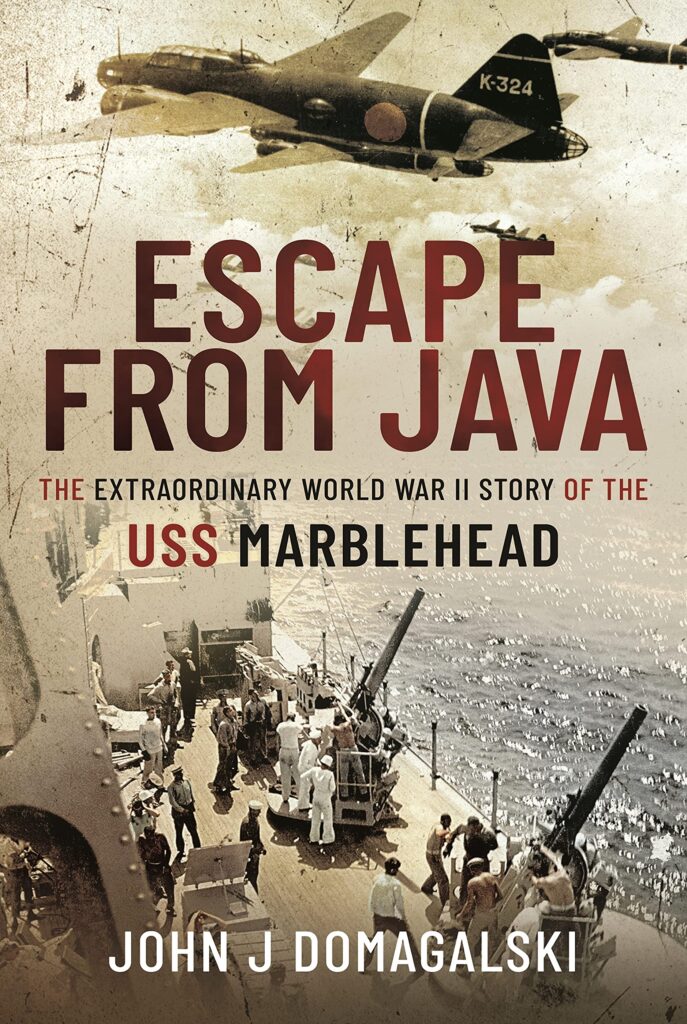Reviewed by Jeff Schultz
John J. Domagalski’s Escape from Java: The Extraordinary World War II Story of the USS Marblehead delves into the gut-wrenching experiences of an aging light cruiser caught up in the early Pacific War as part of the US Asiatic Fleet. Almost lost to enemy air attack and badly damaged during the Battle of the Flores Sea, the Marblehead’s crew fought desperately to keep their ship afloat which ultimately saved the day.
Domagalski is a historian with multiple books and articles to his credit, often focusing on the Pacific War. The book consists of thirty-three chapters broken into several larger sections such as “War Clouds”, “Pacific in Flames,” “Fire from the Sky,” “Escape,” and “The Long Journey Home,” along with an epilogue, bibliography, endnotes and index. The text uses a large amount of eyewitness account excerpts woven into the narrative, supported with a photo section and a few helpful maps. This is one of the more seamless ship-based biography with the right amount of balance between the narrative and the many primary source pieces which flesh out the arcane elements coherently.
Domagalski argues in this ship’s memoir that Captain Arthur Robinson’s resourceful crew made the difference, from the commanding officer down to the mess stewards, all of whom took part in the “herculean task” to save their ship. Everyone contributed in this all-encompassing team effort which permitted the ship to recover from the terrible beating it took from Imperial Japanese Navy “Betty” bombers on Wednesday, 4 February 1942, which nearly sank the vessel with two direct hits and a near miss which badly damaged the hull underwater. Several other ABDA cruisers were lost to enemy action in the East Indies campaign, including the USS Houston, HNLMS De Ruyter and HMS Exeter due to the Japanese control of the skies which makes this story all the more remarkable.
Marblehead was part of the Omaha-class of postwar light (“scout”) cruisers launched in the 1920s with four smokestacks which gave them a distinctive appearance reminiscent of the smaller “four piper” destroyers of the Wickes and Clemson classes. Top-heavy, with a suboptimal armament layout, the Omaha’s did not prove successful against more modern Japanese designs they encountered. Poorly equipped to deal with modern air threats, the ship lacked a suitable anti-air capability which was only remedied in later refits which allowed the ship to take part as support vessel for August 1944’s Operation Dragoon.
Domagaski follows the light cruiser from prewar to war’s end, along the way providing a brief glimpse of the US Asiatic Fleet which served mostly in China until forced to withdraw to the Philippines as war loomed. In this way the book is not only the Marblehead’s story but also that of the larger Asiatic Fleet which makes it more than merely a narrow look at one ship.
Admiral Thomas Hart, the commander of the Asiatic Fleet at war’s beginning, plays an important part in the story, which Domagalski wisely interweaves with the Marblehead’s exploits, is a critical figure that like the light cruiser, was a product of the prewar Navy who had one last war to fight. Hart’s combat career ends after the East Indies debacle but he continued on in administrative roles much as the repaired light cruiser did in the South Atlantic, serving the larger Allied cause in a secondary theater.
Domagalski spends considerable time discussing the damage control efforts. This part of the book in particular is a tribute to the brave crew, a number of whom were killed or wounded in the air attacks. While the two direct hits caused considerable damage, the underwater near miss caused a disproportionate amount of trouble for the crew much as the heavy rudder damage which initially prevented anything other than circles. It was not until much later that the rudder could be properly repaired, so local ingenuity reduced the problem along with using engines to help steer the ship in the correct direction as an expedient solution.
Aside from considerable suffering, there were some bright spots in the journey, such as when Marblehead escaped potential destruction in the cramped port of Tjilatjap on Java’s south coast, then later escaped again from British-held Sri Lanka, leaving for South Africa before Admiral Nagumo’s carriers raided the area for considerable loss and finally the sheer fact that the ship held together as it sailed alone limping over a great distance on its way to Brooklyn Navy Yard.
Among the vignettes featured is that of Dr. Corydon Wassel, USN who performed incredible feats which would be recounted by President Roosevelt in a “fireside chat” of 28 April 1942 later to the delight of a mass radio audience begging for heroes in the dark early days of the war. He took charge of ten US Navy wounded from USS Houston and Marblehead who had been offloaded as too badly wounded to continue a sea journey, but refused to abandon them; shepherding them using sheer force of will and luck via Dutch trains and ambulances plus a fortuitous British motorized column. Eventually they had a timely escape aboard the Dutch merchant ship Janssens from the endangered port of Tjilatjap and on to Australia after a harrowing encounter with strafing Japanese Zeroes, earning the Navy Cross for his brave actions. The Marblehead’s intrepid skipper Captain Robinson and several other sailors also earned the same prestigious decoration.
Domagalski’s Escape from Java: The Extraordinary World War II Story of the USS Marblehead paints an engrossing tale of an obsolescent ship’s survival amid great odds set against the brutal early fighting of the Pacific War. This book will appeal to a wide audience not only as high wartime adventure but simply as a story of gritty perseverance when the odds are heavily against.
A past contributor, Schultz teaches history at a community college in Pennsylvania.
Escape from Java: The Extraordinary World War II Story of the USS Marblehead. By John J. Domagalski (Barnsley, UK: Pen and Sword Military, 2022).


